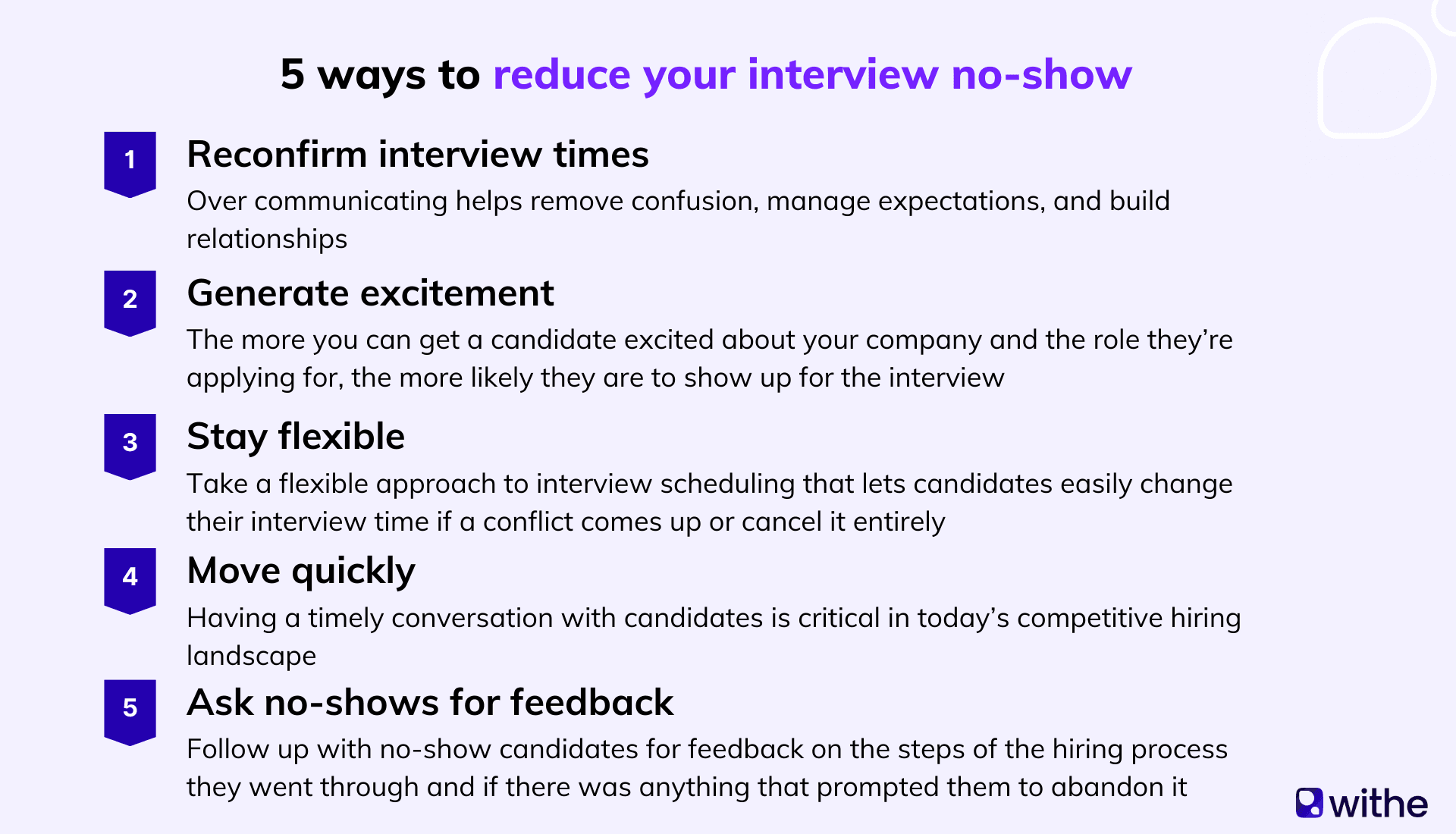Leverage Withe's hiring event platform
Streamline your seasonal and high-volume hiring process and hit your hiring targets.
As a recruiter, how long do you spend preparing for an interview? You likely spend some time reviewing the candidate’s profile and resume, preparing some specific questions as you go along. You make sure that anyone else joining the call is prepared, whether that’s the hiring manager or a peer interviewer. Plus, then you mentally prepare for the call and maybe log in a few minutes early — if it’s virtual — to make sure the candidate isn’t left waiting.
And how do you feel about dedicating all that time to a candidate when they don’t show up for the interview?
Interview no-shows are a problem area for today’s recruiting teams. A candidate will agree to a scheduled appointment, and then ghost the interviewer without any warning whatsoever. This can happen for a variety of reasons. A candidate might accept another job offer and forget to let you know. Another might decide that the role isn’t a good fit after all, but feel uncomfortable communicating that. And others might just get cold feet.
Unfortunately, this is a trend that affects most recruiters. While it’s more common for lower-paying roles or part-time gigs, candidate ghosting can happen to any company for any position — and it’s annoying every time. No-shows ultimately hinder your recruiters’ productivity by wasting their time, and they also limit the number of people you end up talking to for a role. So, how do you avoid it?
The best thing you can do when trying to reduce the chance of no shows in interviews is to take a proactive approach. Whether it’s introducing automated communications or doing more work upfront to generate excitement around a role, it’s worth investing a little more time to save your recruiters from wasting time waiting for candidates down the line. Here are some best practices that can help you do just that.
Leverage Withe's hiring event platform
Streamline your seasonal and high-volume hiring process and hit your hiring targets.
1. Confirm the interview time — and then confirm it again
Overcommunicating isn’t always a bad thing. In fact, it can be quite useful in a hiring scenario as it helps set expectations and build relationships — and it can also prevent having to wait around for no-shows. Recruiters can send multiple messages to candidates confirming and reconfirming the interview time, while also giving them a chance to cancel if they need to.
You can use an automated messaging flow here. For example, once an interview time is confirmed, you can have an automated message set to go out 24 hours before the scheduled appointment where the candidate has to re-confirm that they will attend. If they don’t confirm by an hour before the interview, you can send out another note and give them the option to reschedule or cancel. For candidates that are nervous about reaching out, this can give them an easy way to opt out of the interview process without wasting your time.
2. Generate interest in your employer brand
The more you can get a candidate excited about your company and the role they’re applying for, the more likely they are to show up for the interview. You can generate this excitement in a number of ways:
- Build a strong employer brand that communicates your company’s values, culture, and more.
- Have a section of your corporate website dedicated to career opportunities, employee stories and other employer brand details.
- Use your social media channels to communicate with candidates.
- Make your job descriptions detailed: give a clear picture of role expectations, career progression opportunities, and team structure.
However you communicate with candidates, make sure it’s genuine. Today’s job seekers expect companies to be transparent and clear — and if they feel that you’re not being authentic, they’re much less likely to do you the courtesy of showing up for an interview.
Withe helps hiring teams reduce interview no-shows with virtual hiring events and on-demand video interviews
3. Stay flexible
Take a flexible approach to interview scheduling that lets candidates easily change their interview time if a conflict comes up or cancel it entirely. Today, many job seekers are already employed and that means they’re juggling interviews with full-time jobs or other commitments. As such, if your recruitment team is up for it, consider a flexible schedule for interviews that includes slots during lunch time or after the typical work day.
Remember, it’s a candidate market out there, so providing a flexible experience that shows you understand what candidates are dealing with on a day-to-day basis can help enhance your reputation as an employer.
4. Move quickly
Timing is everything in recruiting — especially in the current talent landscape — and for many recruiters, there’s a huge benefit to getting in front of candidates early and having a real conversation. For example, in high-volume hiring industries such as the hospitality sector, a one-on-one conversation can make the difference when a candidate is deciding between two competing job offers.
Leveraging the right tools is important here. As one example, on-demand video interviews can help your recruiters meet with candidates faster and build relationships that encourage offer acceptances down the line.
5. Consider asking for feedback
Your no-shows may have a myriad of reasons for not attending their interview, but you’ll never be able to know if it’s something you’re doing unless you ask. When candidates don’t show up, consider checking in and asking for feedback around the steps of the hiring process they went through and if there was anything that prompted them to abandon it. You can do this with an automated email that goes out as soon as the candidate is marked as a no-show.
While you won’t get an answer from everyone, the responses you do get may indicate that your recruitment team isn’t acting fast enough to make interviews happen, or that there wasn’t enough communication around the role to generate excitement. In any case, you’ll have important learnings to incorporate into your strategy.

Candidates have more choices than ever
A big reason that no-shows are so prevalent at the moment is because candidates are navigating more choices than ever. They’re applying to lots of jobs and getting lots of responses, so if your recruiters don’t move quickly or don’t communicate effectively, the chance of a no-show is high.
Taking a proactive approach to reducing no-shows — and enhancing the candidate experience as a result — is bound to set your team up for success.
Interview no-shows FAQs
To provide a little more context on interview no-shows, here are some frequently asked questions posed by recruiters:
Why do candidates not show up for interviews?
There are a number of reasons for why candidates might fail to show up for their scheduled interview. These include the following:
- The candidate received a job offer from another company and forgot to reach out to cancel the interview.
- They decide the role isn’t a fit for them, for whatever reason, but feel awkward communicating that.
- They are confused about the role or the role doesn’t meet their expectations, so they drop out of the running without making it known to the recruiter.
- They got confused about the time or date of the interview.
- The candidate was dealing with a personal or family emergency and couldn’t communicate that they wouldn’t make it.
How do interview no-shows impact the hiring process?
Interview no-shows make it harder for recruitment teams to be efficient when they’re hiring for a new role. For recruiters that need to move quickly and at scale, like those running volume hiring events, no-shows can significantly slow down progress and extend the time needed to fill each role.
What are the recruitment costs associated with interview no-shows?
There is a lot of time and effort that goes into hiring a new employee, and a lot of that time is spent evaluating potential candidates by screening them, communicating with them, and interviewing them. When a candidate doesn’t show up to an interview, recruiters waste a lot of time prepping and waiting for them — time that could have been spent on someone they are more likely to hire. Ultimately, no-shows make recruiting teams more inefficient, making it harder for them to meet core metrics.
At Withe, we’re helping high-volume recruiters eliminate no-shows. Learn how our on-demand video interview software can help.




